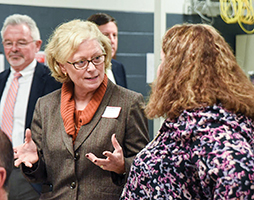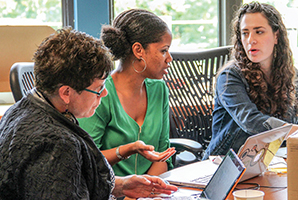
Micro-Credentials: The Badges of Professional Growth
A new form of professional development that focuses on demonstrated mastery of teaching skills and know-how
BY BARNETT BERRY/
School Administrator, November 2016
 |
Barnett Berry, CEO of the Center for Teaching Quality, at a July retreat
in Carrboro, N.C., where he addressed the use of micro-credentials in
teacher growth. (Photo courtesy of Center for Teaching Quality.)
|
Sam Brooks, a personalized learning coordinator in Putnam County Schools in Cookeville, Tenn., has worked as an educator for 24 years but he’s never been more hopeful about the future of teaching and learning. I got to know Brooks this past summer when my organization, the Center for Teaching Quality, visited Tennessee to lead a statewide conversation on a transformative approach to professional development known as micro-credentials.
You may have heard of digital badges, which a dizzying range of organizations have used to acknowledge professional and recreational achievements of young people and adults. Inspired by badging, micro-credentials recognize educators’ professional learning.
The new approach emphasizes the evidence of educators’ learning, rather than focusing on “seat time.” It’s about
how practitioners mastered a specific competency.
A Resonating Idea
This idea resonates with educators like Brooks, who helps coordinate Putnam County’s ambitious efforts to personalize learning for its 11,000 students.
The school district recognizes that preparing all young people for accelerating and unparalleled change — in a world rife with revolutionary technologies — requires big shifts in teaching and learning. Students not only must master important concepts and facts but also demonstrate they can think critically, tackle sophisticated problems and effectively communicate what they know and can do. And this means teaching must look different — as it does for Putnam County students, thanks to personalization efforts.
But Brooks and his colleagues have identified a challenge. Teachers struggle to address this shift in their teaching when they are not experiencing it in their own learning. “We must get rid of professional development as we know it,” Brooks argues, “and create hands-on opportunities for teachers to mold their own teaching and learning.”
His comments echo scholars’ findings about factors common to effective professional development (
http://bit.ly/PDevidence). Professional development tends to be job-embedded, inquiry-driven and collaborative.
However, few teachers nationwide have access to training of this kind. A 2014 report (
http://bit.ly/teachersknowbest) by the Bill & Melinda Gates Foundation outlined the woeful state of our nation’s $18 billion professional development enterprise. Among the dismal findings: Fewer than one in three teachers choose most or all of their professional learning opportunities.
 |
Kathleen Airhart (center), Tennessee Department of
Education’s deputy commissioner, is supporting a statewide pilot project
on the use of micro-credentialing to advance teacher professionalism. (Photo courtesy of Tennessee Department of Education)
|
A Statewide Focus
School administrators in Tennessee, such as Kathleen Airhart, Putnam County’s former superintendent and now the Tennessee Department of Education’s deputy commissioner and chief operating officer, take seriously the link between what students need to know and do and how teachers learn.
That’s why, when convening a statewide task force on personalized learning to expand online or blended courses and create a competency-based high school diploma, the state education department added another charge — individualizing teachers’ professional development. Airhart, who leads the 24-member taskforce, is optimistic about how Tennessee can pilot micro-credentials for educators to address this challenge.
But how do micro-credentials work? And how can school systems leverage them to drive big changes in teaching and learning, especially with opportunities posed by the passage of the federal Every Student Succeeds Act?
An Emerging Ecosystem
The micro-credentialing movement, involving dozens of education organizations and agencies, is taking shape with leadership by Digital Promise, a nonprofit based in Redwood City, Calif. Partnering with BloomBoard, an online professional development platform, Digital Promise is offering opportunities for educators to document formal and informal learning in bite-sized pieces. Teachers and administrators can use work samples, videos and other artifacts to make public what they have mastered and accomplished with their students and colleagues. Based on this evidence, assessed against established rubrics, educators then earn recognition for what they’ve achieved.
As of late summer, more than 30 content partners have developed more than 200 micro-credentials — organized in “stacks” — to address a variety of educator skills and competencies.
Micro-credentials focus on granular competencies, ranging from “teaching practices for deeper learning” (issued by Digital Promise) to more traditional pedagogical skills such as “data literacy” and “wait time” (issued by the Relay Graduate School of Education with campuses in nine states). Teacher leadership is a focal area for some micro-credentials, such as the Center for Collaborative Education’s stacks on “performance assessment design” and “leading a performance assessment community” or the Center for Teaching Quality’s “teacher-powered” stack. The latter includes “building your team,” “cultivating a shared purpose” and “ensuring alignment to the shared purpose.” Some micro-credentials specifically address skills critical for administrators.
 |
Participants in Center for Teaching Quality’s July conference learned how to use micro-credentials in professional advancement. (Photo courtesy of Center for Teaching Quality)
|
How It Works
Each micro-credential in the Digital Promise ecosystem includes six components: competency, key method, method components, research and resources, submission criteria and scoring rubric.
The process works in this way: Individually or in teams, educators identify and develop important skills, submit proof of their competence and earn digital badges verifying their expertise. Required evidence might include a portfolio, video, student work, classroom observations, teacher and student reflection and/or other documentation of their learning in action. After trained assessors judge the evidence, the issuing organization determines whether the teacher should be awarded the micro-credential. Depending on a teacher’s skills and experiences, some micro-credentials may take no more than an hour to submit, while others may take weeks.
The micro-credentialing movement is still in its infancy. But a recent national survey by Grunwald Associates (
http://bit.ly/surveymcs) of teachers who had been introduced to the concept found budding interest. About 31 percent reported they are “extremely likely” or “very likely” to try micro-credentialing and another 34 percent said they are “somewhat interested.”
Several school districts, including Wales, Wis.; Vista, Calif.; and Baltimore County, Md., have begun to capitalize on the possibilities of micro-credentials to ratchet up professional development. Beginning in 2015-16, Baltimore County, in an effort to focus personalized student learning, supported teachers in their use of Digital Promise’s “deeper learning” stacks. Teachers can earn a specified number of continuing education units for earning micro-credentials, and now the district is considering how they can count for re-certification or master’s degree equivalency.
It’s easy to see the merits of personalizing educators’ learning. The process integrates informal modes of learning that educators already are pursuing and encourages focused, productive collaboration. And micro-credentials can help educators avoid reinventing the wheel by identifying and learning from colleagues with demonstrated expertise.
Micro-credentials value teacher-led learning, a certain factor that can lead to increased efficacy as well as retention. Yet the approach is drawing system leaders’ interest for other reasons as well.
Micro-credentials can yield rich data about the teaching workforce’s skills, interests and capacity. School system leaders can tap this data to optimize investments in professional learning, informing decisions about the demand for and effectiveness of specific opportunities.
A micro-credentialing system also can reveal gaps in the workforce, allowing for targeted recruitment. Finally, micro-credentials enable leaders to identify teachers with specific expertise who might be well-positioned to lead their colleagues’ learning or spearhead specific reforms.
Piloting Credentials
In recent years, Tennessee has been one of the states implementing ambitious teaching reforms that address evaluation, professional learning and leadership. Teachers are receiving more high-quality feedback than ever before through the Tennessee Educator Acceleration Model (
http://bit.ly/TNteam), the state’s teaching evaluation rubric. Yet teachers report the feedback from peers and instructional coaches is not always actionable. As Airhart asserts, “Teachers crave the kind of feedback and resources that micro-credentials can offer, and we have a tiered licensing system that could offer them credit for their learning and leadership.”
Here’s how the state’s micro-credentialing pilot will unfold. In 2016-17, 30 highly effective teachers will be paired with 30 novices in their respective school districts. Throughout the year, the teachers will submit evidence on several Digital Promise micro-credentials aligned with the TEAM rubric, focusing on specific areas (e.g., thinking, questioning and problem solving) that previously proved daunting for teachers — and for the administrators responsible for delivering actionable feedback.
Supported by the state education agency and the Center for Teaching Quality, pilot participants will collaborate in a virtual community, sharing resources and reactions to the micro-credentialing process. The Tennessee Department of Education will look to these participants as a design team that can inform the content, process and support structures needed to implement micro-credentials with all beginning teachers.
In 2017-18, state leaders plan to link micro-credentialing to Tennessee’s system for licensure advancement. “We are optimistic,” Airhart says, “that at least 25 percent of our novice teachers will opt into micro-credentialing as their route to obtain professional development points.”
During the second year of the pilot, the state also expects to launch an empirical examination of the micro-credentials, drawing on a range of evidence (e.g., TEAM results, surveys and more) as a research team will compare teachers who have earned micro-credentials for licensure advancement with peers using more traditional models of professional development.
Airhart anticipates the micro-credentialing movement will expand in future years to support much-needed reforms, including the creation of innovative teacher leadership pathways, the identification of expert evaluators and coaches and cultivation of virtual communities of practice on a range of instructional topics. “It’s likely that expert teachers and administrators in Tennessee will design some micro-credentials to complement those offered by Digital Promise’s partners, addressing competencies relevant to districts’ pressing needs and teachers’ interests,” she says.
Challenges Ahead
No doubt micro-credentialing is in its nascent stages — and there are far more questions than answers. My conversations with Brooks, Airhart and their colleagues highlighted just a few of the issues Tennessee education leaders must confront. One of these is how to guarantee the quality of micro-credentials the state endorses, the reliability of assessment and wise reallocation of existing professional development dollars.
These are not easy questions, but the challenges can be surmounted. In my work with teachers and administrators across the nation, a simple truth shines through (also backed by national survey data). As the Digital Promise tagline (and hashtag) states: Teachers and administrators
#love2learn.
The task of school system leaders is to maximize this professional strength, stripping away what doesn’t work to create an agile, data-rich approach that recognizes individual accomplishments and needs as well as collective expertise. For too long, professional development has meant seat time in mandated workshops, not the tangible, evidence-based demonstration of skills and growth. Micro-credentials offer tremendous potential for supporting teachers to transform teaching and learning for all students.
BARNETT BERRY is founder and CEO of the Center for Teaching Quality in Carrboro, N.C. E-mail:
bberry@teachingquality.org. Twitter:
@BarnettCTQ and
@teachingquality
Additional Resources
Curious about micro-credentials?
School Administrator contributors Barnett Berry of the Center for Teaching Quality and Patricia Deklotz of the Kettle Moraine School District suggest these informational resources.
»Digital Promise’s one-minute introductory video (
www.youtube.com/watch?time_continue=2&v=KdWRkl8rDiU)
»Empirical evidence, educational trends and potential benefits: A paper by CTQ and Digital Promise (
http://bit.ly/microcreds)
»The websites of CTQ (www.teachingquality.org) and Digital Promise (
http://digitalpromise.org)
»Kettle Moraine’s video “Future Ready: Micro-Credentialing for Professional Learning” (
www.youtube.com/watch?list=PLhdwy3ASoEfku27IJ2HAKTJhACanSPsg&v=hxgyXmqxYEk)
»CTQ’s stack of micro-credentials on teacher-powered projects (
http://bit.ly/tpmicros)
»
Education Week article “Can ‘Micro-Credentialing’ Salvage Teacher PD?” (
www.edweek.org/ew/articles/2016/03/30/can-micro-credentialing-salvage-teacher-pd.html)